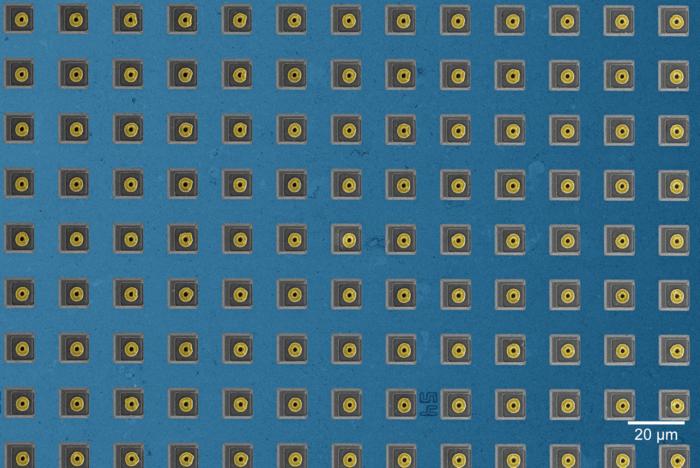
Harvard University has made a groundbreaking advancement in the field of neuroscience by successfully mapping and cataloguing over 70,000 synaptic connections among approximately 2,000 rat neurons. This remarkable feat was achieved using a state-of-the-art silicon chip equipped with an innovative microhole electrode array capable of recording intricately woven signals emitted by numerous neurons simultaneously. This new technology represents a significant leap forward in the quest to understand the connections that underlie brain function, paving the way for more detailed synaptic connectivity maps.
The research, published in Nature Biomedical Engineering, showcases a unique combination of advanced engineering and neuroscience methodologies. Traditionally, researchers have faced considerable obstacles in obtaining the intracellular access needed to record neuronal signals from multiple neurons at once. The primary method used, the patch-clamp technique, provides accurate measurements of synaptic strength but typically restricts researchers to recording from only a few neurons simultaneously. The breakthrough achieved by this Harvard team not only enhances the scale at which recording can occur but also augments the extent of data that can be collected for analysis.
Central to this achievement was the development of the microhole electrode array, which consists of 4,096 electrodes integrated onto a silicon chip. These electrodes provide a substantially improved interface with the neurons, allowing scientists to obtain intracellular recordings from a larger number of neurons in parallel. Co-lead authors Jun Wang and Woo-Bin Jung emphasized that the design of this array closely resembles that of a traditional patch-clamp electrode but with the added advantage of easier fabrication and superior coupling with the neurons.
The use of microhole electrodes allows for not only the detection of synaptic signals but also the extraction of critical data concerning the strength of these connections. The impressive figure of over 70,000 identified synaptic connections highlights the unparalleled capability of this technology compared to previous methodologies, which generally limited researchers to identifying only a few hundred connections at best. The quality of the recorded data is also vastly improved, enabling the team to discern the characteristics of each synaptic connection distinctly.
As detailed in the publication, the researchers operated the silicon chip by delivering slight electrical currents through the electrodes. This approach gently opens the cell membranes, creating a pathway for neurons to establish intracellular contact with the electrodes. With more than 90 percent of electrodes successfully coupled to neurons, the efficiency of recording dramatically surpassed expectations, allowing for a comprehensive mapping of synaptic connectivity over an expansive network.
One of the most significant challenges faced during the research process was managing the overwhelming volume of data generated from the recordings. The Harvard team has made substantial strides in developing analytical methodologies that help interpret the complex datasets, thereby yielding insights into the network dynamics of synaptic connections. Additionally, the integrated electronics of the silicon chip not only facilitate the recording process but also play a vital role in the delicate balance of stimulating and monitoring cellular activity.
The implications of this work extend beyond merely cataloguing synaptic connections. It holds the potential to transform our understanding of how neurons communicate and interact within brain networks, which is foundational for higher-order cognitive functions such as learning and memory. As researchers continue to investigate neuronal connectivity, this technological advancement will undoubtedly serve as a pivotal tool in elucidating the complexities of neural circuits.
Furthermore, the collaborative efforts of researchers across different departments underscore the interdisciplinary nature of modern neuroscience research. Contributing scientists, such as Rona S. Gertner and Hongkun Park, have brought valuable insights from their respective fields, enhancing the overall rigor and impact of the study. The research was supported by the Samsung Advanced Institute of Technology, reflecting the growing partnership between academia and industry in advancing scientific frontiers.
In future directions, the team aims to refine their designs further to deploy similar technologies within living organisms, specifically targeting the challenge of recording from neurons in real-time under physiological conditions. This goal signals an exciting frontier in brain research, with the potential to revolutionize our understanding of how neuronal networks function dynamically in real-world settings.
This pioneering work not only highlights the potential for technological advancements in neuroscience but also emphasizes the need for innovative approaches to studying complex biological systems. As the boundaries of what can be achieved continue to expand, the field of neuroscience stands at the precipice of new discoveries that could fundamentally alter our understanding of the brain’s architecture and functionality.
In summary, the recent research by Harvard scientists represents a significant leap forward in neuronal recording techniques, marrying advanced engineering with cutting-edge neuroscientific inquiry. This development has opened up a wealth of opportunities for future research aimed at uncovering the profound mysteries hidden within the brain’s intricate web of synaptic connections. The strong emphasis on data analysis and technology integration sets the stage for a more comprehensive understanding of neuronal mechanisms that underpin behavior and cognition.
Subject of Research: Synaptic connectivity mapping
Article Title: Synaptic connectivity mapping among thousands of neurons via parallelized intracellular recording with a microhole electrode array
News Publication Date: 11-Feb-2025
Web References: Nature Biomedical Engineering
References: DOI – 10.1038/s41551-025-01352-5
Image Credits: Credit: Ham Group / Harvard John A. Paulson School of Engineering and Applied Sciences
Keywords
/ Life sciences / Neuroscience / Neurophysiology / Synaptic connections / Neuronal networks / Microhole electrodes / Massively parallel recording / Neuron-to-neuron interaction / Synaptic strength / Silicon chip technology / Electrophysiology / Brain research / Neuroengineering
Tags: brain function connectivity analysisHarvard neuroscience advancementsinterdisciplinary engineering and neurosciencelarge-scale neuronal data collectionmicrohole electrode technologyNature Biomedical Engineering publicationneuronal network mappingpatch-clamp technique limitationssilicon chip innovations in neurosciencesimultaneous neuronal signal recordingsynaptic connectivity researchsynaptic strength measurement techniques





